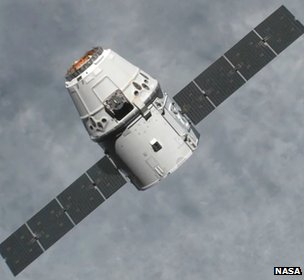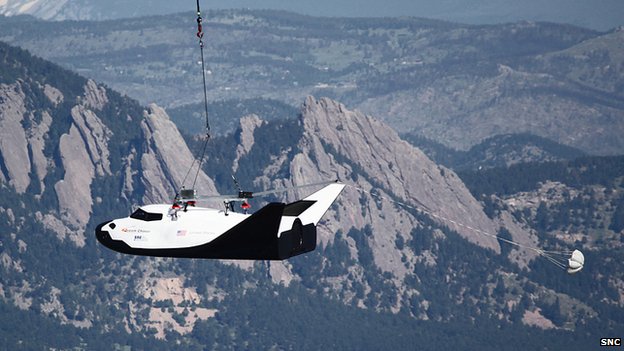
California's SpaceX company says it expects to start launching humans into orbit in its Dragon capsule in 2015.
 Its intention is to be able to deliver a crew to the International Space Station by the end of that year.
Its intention is to be able to deliver a crew to the International Space Station by the end of that year.
The first flights would carry the company's own test pilots - not US space agency (Nasa) astronauts.
"We're not selling tickets. Don't call our toll-free number," joked Garrett Reisman, SpaceX's commercial crew project manager.
The company is already in receipt of a contract from the agency to deliver cargo to the ISS using an unmanned version of Dragon, but it is working on adapting the vehicle so that it can carry people as well.
This involves installing life-support systems and developing the necessary emergency procedures to protect astronauts should anything go wrong on launch.
To that end, SpaceX is working on abort technologies that would lift the capsule away from its rocket during flight, allowing it to drop safely back to Earth via parachutes.
Mr Reisman, who himself flew twice to the space station as a Nasa astronaut, said the company would conduct an important test of these abort procedures later this year.
This would involve putting a Dragon on top of one of its Falcon rockets on the launch pad and then firing the capsule's own thrusters to push it clear into the sky. This demonstration would be followed later in 2014 by an in-flight abort test.
Mr Reisman was coy about whether he would be in the initial SpaceX test crews in 2015. "It's not important that I go but I have to be willing to go because I'm not strapping somebody else into it if I'm not willing to strap into it myself," he told reporters.
He was speaking at Nasa's Kennedy Space Center where the agency had brought together a panel of companies to update the media on the progress they were making in developing crew transportation systems to low-Earth orbit.
Since the retirement of the shuttles in 2011, America has had no means of launching its own astronauts into space and has been purchasing rides in Russian Soyuz vehicles at the cost of $60m a seat.
Nasa is trying to seed an indigenous commercial market in crew transport services. It has so far committed about $1.5bn to the initiative. The companies are also investing their own funds.
SpaceX is the most advanced in its plans, but the Boeing company and the Sierra Nevada Corporation hope also to grab a sizeable part of this nascent market.
Boeing is building a conical capsule known as CST-100 that will fly atop an Atlas 5 rocket. It proposes to conduct a three-day orbital mission in 2016. Like SpaceX, Boeing will use its own employees for the early demonstration flights.
"It's really emotionally and strategically important that this country is a spacefaring nation and we're really excited to get back to that point," said John Mulholland, Boeing's commercial programs space exploration vice president
Sierra Nevada Corporation is more reticent in setting a target date for its first foray into orbit. The Colorado-based company is developing a small shuttle-like vehicle known as the Dream Chaser. This also would use the Atlas 5 rocket.
In the coming months, SNC intends to drop an unmanned test version of Dream Chaser from a carrier plane to make an automated glide and approach to a runway.
"It's not outfitted for orbital flight; it is outfitted for atmospheric flight tests," explained Mark Sirangelo, Sierra Nevada Corp vice president and SNC Space Systems chairman.
"The best analogy - it's very similar to what Nasa did in the shuttle programme with the Enterprise, creating a vehicle that would allow it to do significant flights whose design then would filter into the final vehicle for orbital flight."
Mr Sirangelo emphasised SNC's stepwise approach to getting into space, with the first launches going only suborbital (a short hop above the atmosphere) followed eventually by fully orbital sorties. The programme called for a mixture of autonomous and piloted flights, he added.
The Blue Origin company, which received funds from Nasa for some of its early development work, said it continued to work on a crew transport system even though it was no longer getting any financial support from the agency. The firm, established by Amazon entrepreneur Jeff Bezos, has a design for a capsule and two-stage rocket. It has already conducted test firings on its all-new liquid-hydrogen/liquid-oxygen rocket engine, known as the BE-3. It has also done an abort test of a capsule structure, blasting it into the sky from the ground and then recovering it on parachutes.
Nasa would like to be purchasing crew services from one or more companies by 2017. Whether this target is achievable will depend on how much money it has available to invest in its commercial crew initiative.
The sums requested for the programme by President Barack Obama have routinely been adjusted downwards by Congress. He is due to make his Federal Year 2014 request in the next few weeks.
"The budget is going to be an extremely challenging topic, not only for this programme but for all Nasa programmes," said Phil McAlister, the agency's commercial spaceflight development director.

 Previous page
Previous page Back to top
Back to top







